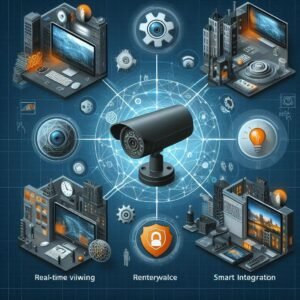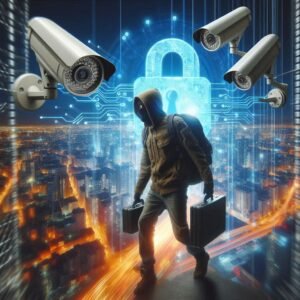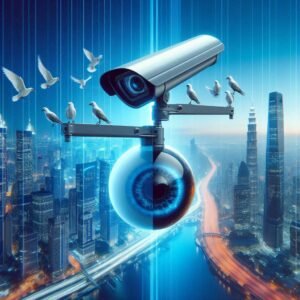Network Security Cameras:
Are They Your Shield of Protection or a Hidden Privacy Risk?

Introduction
In today’s hyper-connected world, security is no longer about heavy locks and tall fences alone. From homes to businesses, people are increasingly relying on network security cameras to deter crime, monitor spaces remotely, and provide peace of mind. These surveillance devices, often connected to Wi-Fi or Ethernet, stream and store footage in real time, ensuring that you always have “eyes” on your surroundings.
But while network security cameras serve as a critical layer of protection, they also open up new concerns. Stories of cameras being hacked, personal data being leaked, or unauthorized surveillance incidents have raised an important question: Are these devices truly protecting you, or are they exposing you to greater risks?
This blog will dive into the advantages, risks, and best practices for using network security cameras, helping you explore whether they are worth the trust you place in them.
The Rise of Network Security Cameras
Not too long ago, security cameras were bulky devices wired to closed-circuit systems, used mainly by banks, government buildings, and corporate offices. Today, thanks to technological advancements, we have compact, affordable, and easy-to-install cameras that connect seamlessly to the internet.
More homeowners are embracing smart security cameras as part of broader smart home setups. Businesses, too, are upgrading old systems with internet-connected models that allow managers to check in remotely.
Market studies predict extraordinary growth in this sector since concerns around theft, vandalism, and workplace safety continue to climb. But as with most smart devices, the convenience of network connectivity comes with its flip side: vulnerability.
Why People Trust Network Security Cameras
Before tackling the risks, let’s acknowledge why these cameras are gaining ground. Their appeal lies in the balance of security, convenience, and smart features. Here are the main benefits:
1. Real-Time Monitoring
Network security cameras allow you to watch live footage from your smartphone, computer, or tablet. Whether you’re traveling or simply at work, you can ensure your property and loved ones are safe.
2. Deter Crime and Misconduct
The visible presence of cameras discourages theft, vandalism, and misconduct in workplaces, schools, and neighborhoods. Criminals often avoid places under active surveillance.
3. Cloud Storage and Playback
Recorded footage is not limited to physical drives. With cloud-based storage, it’s easier to access and back up important clips without manual efforts.
4. Smart Features and Integration
Face recognition, motion detection alerts, night vision, and integration with other smart home systems make these cameras more intelligent than ever.
5. Peace of Mind
Although this is less tangible, knowing you have visibility into your surroundings offers reassurance at a time when security concerns are heightened.

The Other Side: Privacy and Security Concerns
While the benefits are clear, critics argue that network security cameras also pose significant risks. Let’s break them down:
1. Vulnerability to Hacking
Because these devices are connected to the internet, they are vulnerable to intrusion. Hackers can potentially take control of cameras, disable them, or worse, use them as spying tools.
2. Unauthorized Surveillance
One worry is not just about outside hackers but also how manufacturers or third-party service providers may access video feeds. This raises questions about who is truly watching.
3. Data Breaches and Leaks
As camera systems rely heavily on cloud storage, any data breach may expose hours of sensitive video footage, putting users at risk of identity theft or blackmail.
4. Invasion of Privacy in Shared Spaces
Installing cameras in households or workplaces often sparks debates. Employees may feel constantly watched, and even within families, some members may find 24/7 surveillance invasive.
5. Dependence on Internet Connectivity
If the internet fails or is disrupted intentionally, your network cameras may fail to function when you need them most.

Real Stories That Raise Eyebrows
Headlines often bring shocking cases of compromised privacy. From baby monitors being hacked and strangers speaking through them, to smart doorbell cameras being used to spy on homeowners, these cases highlight the risks of connected systems.
For instance, in 2019, a family in Mississippi reported hearing hackers speaking through their child’s bedroom camera. Similar cases globally have spotlighted the urgent need for stronger security protocols in these devices. These stories act as cautionary reminders that while technology is useful, it can be misused if safeguards are not in place.
Balancing Security and Privacy: What Can You Do?
The good news is that network cameras don’t have to be nightmares. By following safe practices, you can maintain their advantages while minimizing threats. Here are practical strategies:

1. Choose Reputable Brands
Always purchase devices from trusted manufacturers with good track records of providing security patches and updates.
2. Regularly Update Firmware
Outdated firmware is one of the easiest backdoors hackers exploit. Set reminders to update your device’s software and security patches frequently.
3. Use Strong, Unique Passwords
Never leave cameras on default factory passwords, and avoid reusing the same password across platforms. Incorporate a mix of letters, numbers, and symbols.
4. Enable Two-Factor Authentication
If supported, turn on an extra layer of login protection so that even if your password is compromised, the account won’t be easily accessed.
5. Segment Networks
Create a separate Wi-Fi network for smart devices, keeping them isolated from your primary computer or phone networks.
6. Position Cameras Thoughtfully
Avoid placing cameras in areas that may compromise personal privacy, such as bedrooms or bathrooms.
7. Review App Permissions
If your camera integrates with apps, monitor what permissions they request. Disabling unnecessary tracking and limiting access strengthens your control.
Ethical and Legal Considerations
Beyond the technical side, there are legal and ethical concerns. In many countries, recording people without consent may violate privacy laws. Businesses installing workplace cameras often need to notify employees clearly. Similarly, homeowners should avoid pointing outdoor cameras toward neighbors’ private spaces to prevent disputes.
Ethically, transparent communication is essential. If everyone in a home or workplace knows why cameras are there and how data is stored, the sense of intrusion is reduced.
Are You Trading Security for Privacy?
This brings us back to the central question: Are network security cameras truly protecting you, or are they costing your privacy? The answer isn’t straightforward.
These devices are powerful tools of security when managed responsibly. But they are also vulnerable and can turn into threats if treated casually. The balance lies in being aware of potential risks, practicing proactive security measures, and setting boundaries around where and why they are installed.
The Future of Network Camera Security
Looking ahead, manufacturers are working on stronger encryption, AI-driven monitoring that alerts suspicious behaviors instantly, and privacy-focused features such as selective recording. Governments too are beginning to enforce tighter regulations on how video surveillance data is handled.
The future likely holds more intelligent, safer surveillance systems. Until then, responsibility rests heavily on the users.

Conclusion
Network security cameras can undeniably safeguard properties, deter wrongdoing, and give peace of mind. However, they also carry an inherent tradeoff between security and privacy, especially as they rely on internet connectivity.
The question is not whether you should install security cameras, but rather how you should manage them. Responsible usage, consistent updates, mindful placement, and awareness of privacy laws can tilt the balance in favor of security, minimizing risks.
So, are they your protection or your privacy risk? The final answer depends on how vigilant and responsible you are as an owner. Used wisely, they can be a shield. Used carelessly, they become a liability.
Pingback: नेटवर्क सिक्योरिटी कैमरे: सुरक्षा की ढाल या प्राइवेसी के लिए खतरा?